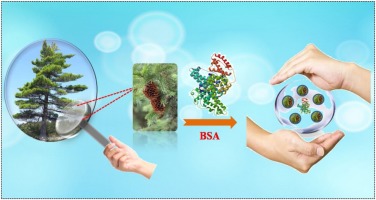当前位置:
X-MOL 学术
›
Colloids Surf. B Biointerfaces
›
论文详情
Our official English website, www.x-mol.net, welcomes your feedback! (Note: you will need to create a separate account there.)
How does bovine serum albumin sustain in saccharomate® derived from pine tree biomass?
Colloids and Surfaces B: Biointerfaces ( IF 5.8 ) Pub Date : 2020-03-23 , DOI: 10.1016/j.colsurfb.2020.110975 Niketa Yadav 1 , Reddicherla Umapathi 1 , Pannuru Venkatesu 1
Colloids and Surfaces B: Biointerfaces ( IF 5.8 ) Pub Date : 2020-03-23 , DOI: 10.1016/j.colsurfb.2020.110975 Niketa Yadav 1 , Reddicherla Umapathi 1 , Pannuru Venkatesu 1
Affiliation

|
Nowadays, research on renewable raw materials and bioresources is a new concern towards the promotion of sustainable process and product development. The use of various plant biomasses such as starch, lignocellulosic and saccharide can be considered as an alternative for using cheaper and less polluting raw materials. In this regard, pine tree biomass, a lignocellulosic forest residue that has various value-added importance and it acts as a model of economic value to the agro-industrial fields. On the other hand, in order to meet and address the challenges of ever-increasing demands of bioresources, there has been significant research interest in deciphering the molecular interactions between proteins and biomass derived substances. No study reports the significance of saccharomate® derived from pine tree biomass on the structural and thermal stability of proteins. There is a sizable interest in the interactions between proteins and biomass derived substances, owing to their utilization and applications. Herein, we used various biophysical techniques such as absorption spectroscopy, fluorescence spectroscopy, circular dichroism (CD) and dynamic light scattering (DLS) to study the impact of pine tree biomass derived saccharomate® (PBDS) on bovine serum albumin (BSA). Further for better understanding of morphological changes of BSA in presence of biomass, Transmission electron microscopy (TEM) was also studied. The present study revealed that the increasing concentration of saccharomate® perturbs structural stability however; the thermal stability of BSA remained unchanged. The transition temperature of BSA remained approximately same in presence of different concentrations of PBDS. Furthermore, the size of BSA increases from 9.22 nm to 135.58 nm in presence of higher concentration of PBDS as revealed by DLS studies. To the best of our knowledge, the results represent first detailed proof of the unusual effect of PBDS on the model protein BSA.
中文翻译:

牛血清白蛋白如何在源自松树生物质的saccharomate®中维持?
如今,对可再生原料和生物资源的研究已成为促进可持续过程和产品开发的新关注点。可以考虑使用各种植物生物量,例如淀粉,木质纤维素和糖,作为使用便宜且污染少的原料的替代方法。在这方面,松树生物量是一种具有各种增值重要性的木质纤维素森林残渣,它可作为农业工业领域的经济价值模型。另一方面,为了满足和应对生物资源日益增长的需求的挑战,对破译蛋白质与生物质衍生物质之间的分子相互作用具有重大的研究兴趣。没有研究报道松树生物质中的saccharomate®对蛋白质的结构和热稳定性的重要性。由于它们的利用和应用,人们对蛋白质与生物质衍生物质之间的相互作用有着极大的兴趣。本文中,我们使用了多种生物物理技术,例如吸收光谱,荧光光谱,圆二色性(CD)和动态光散射(DLS),研究了松树生物质衍生的saccharomate®(PBDS)对牛血清白蛋白(BSA)的影响。为了更好地理解生物质存在下BSA的形态变化,还研究了透射电子显微镜(TEM)。目前的研究表明,saccharomate®浓度的增加扰乱了结构的稳定性。BSA的热稳定性保持不变。当存在不同浓度的PBDS时,BSA的转变温度保持大致相同。此外,DLS研究显示,在存在更高浓度的PBDS的情况下,BSA的尺寸从9.22 nm增加到135.58 nm。据我们所知,该结果代表了PBDS对模型蛋白BSA异常影响的第一个详细证据。
更新日期:2020-03-26
中文翻译:

牛血清白蛋白如何在源自松树生物质的saccharomate®中维持?
如今,对可再生原料和生物资源的研究已成为促进可持续过程和产品开发的新关注点。可以考虑使用各种植物生物量,例如淀粉,木质纤维素和糖,作为使用便宜且污染少的原料的替代方法。在这方面,松树生物量是一种具有各种增值重要性的木质纤维素森林残渣,它可作为农业工业领域的经济价值模型。另一方面,为了满足和应对生物资源日益增长的需求的挑战,对破译蛋白质与生物质衍生物质之间的分子相互作用具有重大的研究兴趣。没有研究报道松树生物质中的saccharomate®对蛋白质的结构和热稳定性的重要性。由于它们的利用和应用,人们对蛋白质与生物质衍生物质之间的相互作用有着极大的兴趣。本文中,我们使用了多种生物物理技术,例如吸收光谱,荧光光谱,圆二色性(CD)和动态光散射(DLS),研究了松树生物质衍生的saccharomate®(PBDS)对牛血清白蛋白(BSA)的影响。为了更好地理解生物质存在下BSA的形态变化,还研究了透射电子显微镜(TEM)。目前的研究表明,saccharomate®浓度的增加扰乱了结构的稳定性。BSA的热稳定性保持不变。当存在不同浓度的PBDS时,BSA的转变温度保持大致相同。此外,DLS研究显示,在存在更高浓度的PBDS的情况下,BSA的尺寸从9.22 nm增加到135.58 nm。据我们所知,该结果代表了PBDS对模型蛋白BSA异常影响的第一个详细证据。


























 京公网安备 11010802027423号
京公网安备 11010802027423号